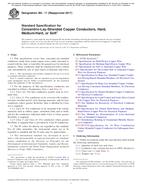We need your consent to use the individual data so that you can see information about your interests, among other things. Click "OK" to give your consent.
ASTM B8-11(2017)
Standard Specification for Concentric-Lay-Stranded Copper Conductors, Hard, Medium-Hard, or Soft
Translate name
STANDARD published on 1.4.2017
The information about the standard:
Designation standards: ASTM B8-11(2017)
Note: WITHDRAWN
Publication date standards: 1.4.2017
SKU: NS-681019
The number of pages: 8
Approximate weight : 24 g (0.05 lbs)
Country: American technical standard
Category: Technical standards ASTM
The category - similar standards:
Annotation of standard text ASTM B8-11(2017) :
Keywords:
concentric-lay-stranded copper conductors, concentric-lay-stranded hard, copper conductors, copper conductors for electrical purposes, medium-hard, or soft copper conductors,, ICS Number Code 29.060.20 (Cables)
Additional information
| 1. Scope | ||||||||||||||||||||||||||
|
1.1 This specification covers bare concentric-lay-stranded conductors made from round copper wires, either uncoated or coated with tin, lead, or lead alloy for general use for electrical purposes. These conductors shall be constructed with a central core surrounded by one or more layers of helically laid wires. Note 1: This specification also permits conductors for use as
covered or insulated electrical conductors.
Note 2: Sealed conductors, that are intended to prevent
longitudinal water propagation and are further covered/insulated,
are also permitted within the guidelines of this
specification.
1.2 For the purposes of this specification, conductors are classified as follows (Explanatory Note 1 and Note 2): 1.2.1 Class AA—For bare conductors usually used in overhead lines. 1.2.2 Class A—For conductors to be covered with weather-resistant (weather-proof), slow-burning materials, and for bare conductors where greater flexibility than is afforded by Class AA is required. 1.2.3 Class B—For conductors to be insulated with various materials such as rubber, paper, varnished cloth, and so forth, and for the conductors indicated under Class A where greater flexibility is required. 1.2.4 Class C and Class D—For conductors where greater flexibility is required than is provided by Class B conductors. 1.3 The SI values for density are regarded as the standard. For all other properties, the inch-pound values are to be regarded as standard and the SI units may be approximate. 1.4 This international standard was developed in accordance with internationally recognized principles on standardization established in the Decision on Principles for the Development of International Standards, Guides and Recommendations issued by the World Trade Organization Technical Barriers to Trade (TBT) Committee. |
||||||||||||||||||||||||||
| 2. Referenced Documents | ||||||||||||||||||||||||||
|
We recommend:
Technical standards updating
Do you want to make sure you use only the valid technical standards?
We can offer you a solution which will provide you a monthly overview concerning the updating of standards which you use.
Would you like to know more? Look at this page.




 Cookies
Cookies
